Tuesday, June 29, 2004
Vinegar - nectar of the Gods
 I shared a tip on my Florida Gardening page a few days ago about vinegar helping the acidity levels for my Canary date palm. Not long ago I also included vinegar as a good solution for sunburn pain. So, I got thinking. What other uses are there for vinegar outdoors? I found The Vinegar Page and hit the motherlode of tips. For instance, did you know that hot vinegar kills weeds? How about this - drinking vinegar will keep mosquitoes away! Vinegar repels ticks and flies, kills slugs, soothes bee stings and reduces the itch from poison ivy. The best thing is that after a hard day in the garden, 2 cups of vinegar in your bath water will ease and add potasium to sore muscles.
I shared a tip on my Florida Gardening page a few days ago about vinegar helping the acidity levels for my Canary date palm. Not long ago I also included vinegar as a good solution for sunburn pain. So, I got thinking. What other uses are there for vinegar outdoors? I found The Vinegar Page and hit the motherlode of tips. For instance, did you know that hot vinegar kills weeds? How about this - drinking vinegar will keep mosquitoes away! Vinegar repels ticks and flies, kills slugs, soothes bee stings and reduces the itch from poison ivy. The best thing is that after a hard day in the garden, 2 cups of vinegar in your bath water will ease and add potasium to sore muscles.The list of vinegar uses when I last visited was at 239 and counting. My head is spinning and I've learned a great deal on how to avoid high cost products by using my trusty old vinegar. It will get rid of the white mineral stains on clay pots and the calcium deposits on bricks. Vinegar can be used for many animal problems, but my favorite is the one shared for dogs who try to make friends with skunks. Supposedly it gets the smell out and leaves a glossy coat. I hope I never have to try that one but glad it worked for that person. Happy Gardening and stock up on your vinegar.
Thursday, June 24, 2004
Hot, hot, hot -- glow
It's been pretty hot lately. The temperature isn't too bad - low 90s during the day. It's the humidity that's torture. I've been watering my gardens pretty steadily since we've witnessed all the storms going around us and, as I do, I notice more and more weeds sprouting up. With all the work I've done getting these beds looking better, I'll be danged if I'm going to let the weeds take over. So, I decided I would get out a few mornings a week before I settled into my workday and start fighting back.
This morning was my first attempt. Armed with my cup of coffee and a stack of newspapers, I began on the front bed. It was loaded with tall grasses that had somehow snuck up on me when I wasn't looking. I worked diligently to get them all pulled and then proceeded to layer the bed with newspapers (remember the recycling thing I shared a while back). There were still six bags of pine bark mulch laying in the driveway so I used that to cover the newspaper. An hour and a half later, the garden looked wonderful. I, however, was covered with dirt and had sweat pouring down my arms and legs. Now the story goes that women glow when they perspire -- don't believe it. Women sweat and it ain't pretty. I'm not ashamed to say I actually had little rivulets forming on the backs of my knees cascading to my ankles. And the doggone ants were stalking me looking for moisture!
 I raked the weeds, packed the garbage cans and headed into the house for a long, refreshing shower. I've been admiring the front garden all day every chance I get. It was hot work, but worth every second. So, the other gardens will get their turn over the next few weeks and by that time the front garden will probably be looking for weed relief again unless the newspaper does what I hope it will. It's a continuing cycle, but a satisfying one. My only disappointment? Maybelline won't be calling me for modeling work anytime soon, not with my "glow". Oh well. Happy Gardening.
I raked the weeds, packed the garbage cans and headed into the house for a long, refreshing shower. I've been admiring the front garden all day every chance I get. It was hot work, but worth every second. So, the other gardens will get their turn over the next few weeks and by that time the front garden will probably be looking for weed relief again unless the newspaper does what I hope it will. It's a continuing cycle, but a satisfying one. My only disappointment? Maybelline won't be calling me for modeling work anytime soon, not with my "glow". Oh well. Happy Gardening.
This morning was my first attempt. Armed with my cup of coffee and a stack of newspapers, I began on the front bed. It was loaded with tall grasses that had somehow snuck up on me when I wasn't looking. I worked diligently to get them all pulled and then proceeded to layer the bed with newspapers (remember the recycling thing I shared a while back). There were still six bags of pine bark mulch laying in the driveway so I used that to cover the newspaper. An hour and a half later, the garden looked wonderful. I, however, was covered with dirt and had sweat pouring down my arms and legs. Now the story goes that women glow when they perspire -- don't believe it. Women sweat and it ain't pretty. I'm not ashamed to say I actually had little rivulets forming on the backs of my knees cascading to my ankles. And the doggone ants were stalking me looking for moisture!
 I raked the weeds, packed the garbage cans and headed into the house for a long, refreshing shower. I've been admiring the front garden all day every chance I get. It was hot work, but worth every second. So, the other gardens will get their turn over the next few weeks and by that time the front garden will probably be looking for weed relief again unless the newspaper does what I hope it will. It's a continuing cycle, but a satisfying one. My only disappointment? Maybelline won't be calling me for modeling work anytime soon, not with my "glow". Oh well. Happy Gardening.
I raked the weeds, packed the garbage cans and headed into the house for a long, refreshing shower. I've been admiring the front garden all day every chance I get. It was hot work, but worth every second. So, the other gardens will get their turn over the next few weeks and by that time the front garden will probably be looking for weed relief again unless the newspaper does what I hope it will. It's a continuing cycle, but a satisfying one. My only disappointment? Maybelline won't be calling me for modeling work anytime soon, not with my "glow". Oh well. Happy Gardening.Saturday, June 19, 2004
Tillandsia cyanea
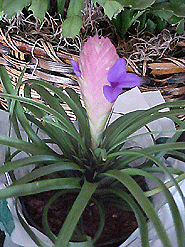 In a previous article I started talking about Latin names and just happened to choose a member of the Bromeliad species to feature. The other morning my husband and I were walking around the grocery store, which we tend to do just about every day, and I noticed a small, potted plant laying on its side. I picked it up and put it in our basket to take home. It was a rather odd looking plant, not so much the leaves but the pink bract emerging from the center. I noticed the name on the tag was Tillandsia cyanea and remembered this from my Bromeliad research. So we brought it home, watered it and left it on the counter where it gets bright but not direct sunlight.
In a previous article I started talking about Latin names and just happened to choose a member of the Bromeliad species to feature. The other morning my husband and I were walking around the grocery store, which we tend to do just about every day, and I noticed a small, potted plant laying on its side. I picked it up and put it in our basket to take home. It was a rather odd looking plant, not so much the leaves but the pink bract emerging from the center. I noticed the name on the tag was Tillandsia cyanea and remembered this from my Bromeliad research. So we brought it home, watered it and left it on the counter where it gets bright but not direct sunlight. 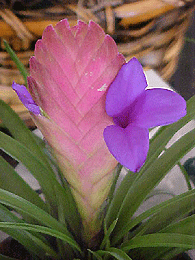 Yesterday morning I got up for my usual coffee and noticed something unusual but gorgeous. The plant was beginning to bloom and what a fascinating contrast. Purple flowers against the pink bract. Tillandsia cyanea blooms in winter with one or two blooms for long periods of time. It must be kept moist and maintained in moderate temps. This picture does not do justice to the absolute beauty of the purple against the pink. I am constantly amazed at the splendor of nature and am so pleased that I found this little plant in the grocery store. Happy Gardening.
Yesterday morning I got up for my usual coffee and noticed something unusual but gorgeous. The plant was beginning to bloom and what a fascinating contrast. Purple flowers against the pink bract. Tillandsia cyanea blooms in winter with one or two blooms for long periods of time. It must be kept moist and maintained in moderate temps. This picture does not do justice to the absolute beauty of the purple against the pink. I am constantly amazed at the splendor of nature and am so pleased that I found this little plant in the grocery store. Happy Gardening.Wednesday, June 16, 2004
Rescues are us
Have you ever been driving down the road and all of a sudden the brakes are hit, the gears placed in reverse and the car flies backward coming to a screeching halt? If not, then you have obviously never been in the car with my husband when he's on a mission. We were driving along having a perfectly pleasant conversation when without warning the scenario described above happened. Since we've been together for 20 something years, I am now accustomed to the behavior although it still takes me by surprise when it takes place. So, we stopped on a, luckily, not busy road. My husband jumped out of the car and came back a few minutes later with something in his hand. Baby turtle and Harlan to the rescue.
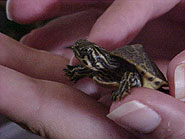 Now I have to admit when I'm driving I don't see all the little movements on the road surface. But I have a very high level of respect for my husband and his ability to do that. I also deeply respect his love of any living being and his desire to help. Having said that, I have to admit I'm not as respectful of the sudden lurching stops and the reverse driving action when there is a truck coming right at us! That's pretty much where I draw the line. So, I find that my profound respect of this usually comes to light when I'm NOT in the vehicle. Be that as it may, it happened again this morning and there was baby turtle.
Now I have to admit when I'm driving I don't see all the little movements on the road surface. But I have a very high level of respect for my husband and his ability to do that. I also deeply respect his love of any living being and his desire to help. Having said that, I have to admit I'm not as respectful of the sudden lurching stops and the reverse driving action when there is a truck coming right at us! That's pretty much where I draw the line. So, I find that my profound respect of this usually comes to light when I'm NOT in the vehicle. Be that as it may, it happened again this morning and there was baby turtle.
So, what to do. The first thing we discussed was taking it home and trying to care for it. But we immediately came to our senses considering we have three dogs and two fairly adventurous cats. We then came to the conclusion we often do in these situations. Let's go see Diane. She'll take care of it. Diane is our feline vet who lovingly treats a variety of animals species except dogs and skunks, and skunks only because she is very allergic. We have taken turtles to her before, as you may recall from other articles, and decided to do so again. This time I told Harlan I would not be the front man. He would have to take the turtle in alone. And he did.
We learned that Harlan rescued a Florida Cooter turtle. They like rivers and marshes and can grow to about 1 1/2 feet in size. Our vet advised the best thing we could do is not keep the turtle captive, but release it in the canal behind our house. Keeping the turtle in an aquarium as a "pet" would only weaken it and contribute to its early demise. By returning it to its natural habitat, we could give the little thing a fighting chance.
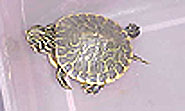 So tonight as the sun is setting and the birds are going home to roost, we are helping our little Cooter settle in his new home. I'm so glad my husband rescued him and gave him a chance to grow and raise his own little family. But, the next time he asks me to go driving, I think I may stay home. Happy Gardening and keep your eyes on the road. The life you save may be a little Florida Cooter.
So tonight as the sun is setting and the birds are going home to roost, we are helping our little Cooter settle in his new home. I'm so glad my husband rescued him and gave him a chance to grow and raise his own little family. But, the next time he asks me to go driving, I think I may stay home. Happy Gardening and keep your eyes on the road. The life you save may be a little Florida Cooter.
 Now I have to admit when I'm driving I don't see all the little movements on the road surface. But I have a very high level of respect for my husband and his ability to do that. I also deeply respect his love of any living being and his desire to help. Having said that, I have to admit I'm not as respectful of the sudden lurching stops and the reverse driving action when there is a truck coming right at us! That's pretty much where I draw the line. So, I find that my profound respect of this usually comes to light when I'm NOT in the vehicle. Be that as it may, it happened again this morning and there was baby turtle.
Now I have to admit when I'm driving I don't see all the little movements on the road surface. But I have a very high level of respect for my husband and his ability to do that. I also deeply respect his love of any living being and his desire to help. Having said that, I have to admit I'm not as respectful of the sudden lurching stops and the reverse driving action when there is a truck coming right at us! That's pretty much where I draw the line. So, I find that my profound respect of this usually comes to light when I'm NOT in the vehicle. Be that as it may, it happened again this morning and there was baby turtle. So, what to do. The first thing we discussed was taking it home and trying to care for it. But we immediately came to our senses considering we have three dogs and two fairly adventurous cats. We then came to the conclusion we often do in these situations. Let's go see Diane. She'll take care of it. Diane is our feline vet who lovingly treats a variety of animals species except dogs and skunks, and skunks only because she is very allergic. We have taken turtles to her before, as you may recall from other articles, and decided to do so again. This time I told Harlan I would not be the front man. He would have to take the turtle in alone. And he did.
We learned that Harlan rescued a Florida Cooter turtle. They like rivers and marshes and can grow to about 1 1/2 feet in size. Our vet advised the best thing we could do is not keep the turtle captive, but release it in the canal behind our house. Keeping the turtle in an aquarium as a "pet" would only weaken it and contribute to its early demise. By returning it to its natural habitat, we could give the little thing a fighting chance.
 So tonight as the sun is setting and the birds are going home to roost, we are helping our little Cooter settle in his new home. I'm so glad my husband rescued him and gave him a chance to grow and raise his own little family. But, the next time he asks me to go driving, I think I may stay home. Happy Gardening and keep your eyes on the road. The life you save may be a little Florida Cooter.
So tonight as the sun is setting and the birds are going home to roost, we are helping our little Cooter settle in his new home. I'm so glad my husband rescued him and gave him a chance to grow and raise his own little family. But, the next time he asks me to go driving, I think I may stay home. Happy Gardening and keep your eyes on the road. The life you save may be a little Florida Cooter. Sunday, June 13, 2004
Latin names
I don't know about you, but I have a hard time remembering and/or identifying latin names of plants. This really came home to roost when I was searching a plant resource site and many of the plants did not have their common name posted, only the latin term. So, I got thinking. I'll bet I'm not the only person puzzled by a plant's latin nom de plume. There have got to be a few hundred others just like me who have to look things up unless it's a species we work with often.
Periodically I am going to feature a plant's latin name and common name and plan to build a little knowledge board on the information page of this site. So, my first pick is Guzmania lingulata. Now you may ask how I came up with that particular plant first. To tell you the truth, I randomly opened my plant encyclopedia and stuck my finger on the first name that popped out. So, Guzmania lingulata it is. What do we know about this plant? Well, it's a bromeliad. A tropical epiphyte, it grows naturally on tree branches by anchorage roots. Ok, what's an epiphyte you ask? According to our friend Webster, it is a plant that derives its moisture and nutrients from the air and rain and usually grows on another plant. Makes sense. Bromeliads form rosettes and produce what are thought to be beautiful blooms but are actually bracts that form a long spike. The spike eventually turns color and finally produces some inconsequential little flowers before it dies.
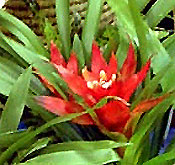 Guzmania can be attached to trees using sphagnum moss wrapped around its roots or can be potted in a high humus soil that drains well. It needs warm, humid conditions to thrive and can be grown indoors with the proper attention. One thing I didn't know about bromeliads is that many are monocarpic, meaning that their rosettes flower only once and then die. But before they flower they form offsets around their base. These offsets can be planted but should not be removed until they're about 1/3 the size of the parent.
Guzmania can be attached to trees using sphagnum moss wrapped around its roots or can be potted in a high humus soil that drains well. It needs warm, humid conditions to thrive and can be grown indoors with the proper attention. One thing I didn't know about bromeliads is that many are monocarpic, meaning that their rosettes flower only once and then die. But before they flower they form offsets around their base. These offsets can be planted but should not be removed until they're about 1/3 the size of the parent.
Bromeliads are gorgeous plants so don't let the latin name intimidate you if you've never grown one. To find more details, visit the Bromeliad Society International.
Well, they say you learn something new every day and I know I just did. I'll share more latin terms frequently. Happy Gardening and watch out for that Oroya neoperuviana (cactus).
Periodically I am going to feature a plant's latin name and common name and plan to build a little knowledge board on the information page of this site. So, my first pick is Guzmania lingulata. Now you may ask how I came up with that particular plant first. To tell you the truth, I randomly opened my plant encyclopedia and stuck my finger on the first name that popped out. So, Guzmania lingulata it is. What do we know about this plant? Well, it's a bromeliad. A tropical epiphyte, it grows naturally on tree branches by anchorage roots. Ok, what's an epiphyte you ask? According to our friend Webster, it is a plant that derives its moisture and nutrients from the air and rain and usually grows on another plant. Makes sense. Bromeliads form rosettes and produce what are thought to be beautiful blooms but are actually bracts that form a long spike. The spike eventually turns color and finally produces some inconsequential little flowers before it dies.
 Guzmania can be attached to trees using sphagnum moss wrapped around its roots or can be potted in a high humus soil that drains well. It needs warm, humid conditions to thrive and can be grown indoors with the proper attention. One thing I didn't know about bromeliads is that many are monocarpic, meaning that their rosettes flower only once and then die. But before they flower they form offsets around their base. These offsets can be planted but should not be removed until they're about 1/3 the size of the parent.
Guzmania can be attached to trees using sphagnum moss wrapped around its roots or can be potted in a high humus soil that drains well. It needs warm, humid conditions to thrive and can be grown indoors with the proper attention. One thing I didn't know about bromeliads is that many are monocarpic, meaning that their rosettes flower only once and then die. But before they flower they form offsets around their base. These offsets can be planted but should not be removed until they're about 1/3 the size of the parent.Bromeliads are gorgeous plants so don't let the latin name intimidate you if you've never grown one. To find more details, visit the Bromeliad Society International.
Well, they say you learn something new every day and I know I just did. I'll share more latin terms frequently. Happy Gardening and watch out for that Oroya neoperuviana (cactus).
Thursday, June 10, 2004
Cell-o-phones
 Recycling is one of my favorite things. You can recycle old pots or chairs and use them as focal points in the garden. Newspapers and cardboard make great mulch as do grass clippings, and of course what would we do without veggie scraps for our compost?
Recycling is one of my favorite things. You can recycle old pots or chairs and use them as focal points in the garden. Newspapers and cardboard make great mulch as do grass clippings, and of course what would we do without veggie scraps for our compost?So I got thinking about recycling consumer goods and shared an article not too long ago about recycling computers. But what about cell phones? What about them, you ask? Well, there was a time when only the elite few had a cell phone. Now we change our phones like we change our garden gloves. The newest and hippest draws some like birds to flower's nectar. So what happens to the old un-new and un-hip phone? Does it get traded in at the phone store? Does it get passed down to the younger sibling like the clothes we passed down in my family? What happens to these cell phones or cell-o-phones, as my mother-in-law would say?
 Well, I came up with a few ideas. How about
Well, I came up with a few ideas. How about - strap them together and make a patio chair - just make sure they're deactivated so your visitors don't start ringing
- make a wind mobile
- whip up a quick plant stand for a garden party
- use them as plant markers
- put them all together and make a sunshade
All tongue-in-cheek, of course, so don't try these at home. But seriously, what's a good way to recycle those old phones? Did you know there are national collection centers that will recycle or refurbish them and donate a portion of the proceeds to charities? Call2recycle wants your phones to help the environment and other would-be cell phone owners. And there are a myriad of other organizations that will do the same. Collectivegood.com, charitablerecycling.com, and Verizon are just a few.
According to the Sierra Club, one million phones are thrown away each week. One million! That's 50 million a year. Fifty million old cell phones leaking toxic substances into the environment. Wouldn't it be great if just one person would think before tossing? Happy Gardening!
Sunday, June 06, 2004
National Gardening Week...
but not officially this week.
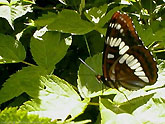
I was reading our local newspaper today over my morning cup of coffee and saw an article about the president of a community garden club. She had taken silk mums to the library "as a visual reminder of the club's celebration of National Garden Week this week." I looked over at my husband and said, "I didn't know it was National Garden Week. I guess I better start doing my homework." He nodded as though he was really listening to what I was saying and looked back at the newspaper.
I put the article on my desk so I could find out more about this special week before sharing with you. Well, here is what I learned. National Garden Week was actually proclaimed in 1986 by President Reagan. Proclamation 5462 speaks to gardening as a "wholesome avocation that encourages appreciation for nature and concern for the preservation and enhancement of our environment." It goes on to reference the season of renewal and the abundance of fruits, vegetables and flowers produced by our gardens. The official week designated by the President and Congress begins in mid-April, which in 1986 was actually April 13.
This pretty much debunks the garden club's president of her declaration but I have a theory. Every week is gardening week whether it's an official proclamation or not. The words signed by President Reagan accurately represent how all gardeners feel about the beauty and bounty of gardening. So, although it's not truly National Garden Week, let's all get out there talk to our plants, pull a few weeds, and celebrate. Happy Gardening.

I was reading our local newspaper today over my morning cup of coffee and saw an article about the president of a community garden club. She had taken silk mums to the library "as a visual reminder of the club's celebration of National Garden Week this week." I looked over at my husband and said, "I didn't know it was National Garden Week. I guess I better start doing my homework." He nodded as though he was really listening to what I was saying and looked back at the newspaper.
I put the article on my desk so I could find out more about this special week before sharing with you. Well, here is what I learned. National Garden Week was actually proclaimed in 1986 by President Reagan. Proclamation 5462 speaks to gardening as a "wholesome avocation that encourages appreciation for nature and concern for the preservation and enhancement of our environment." It goes on to reference the season of renewal and the abundance of fruits, vegetables and flowers produced by our gardens. The official week designated by the President and Congress begins in mid-April, which in 1986 was actually April 13.
This pretty much debunks the garden club's president of her declaration but I have a theory. Every week is gardening week whether it's an official proclamation or not. The words signed by President Reagan accurately represent how all gardeners feel about the beauty and bounty of gardening. So, although it's not truly National Garden Week, let's all get out there talk to our plants, pull a few weeds, and celebrate. Happy Gardening.

This work is licensed under a Creative Commons License.
Thanks to Andrew Stenning who contributed the photograph for our masthead
